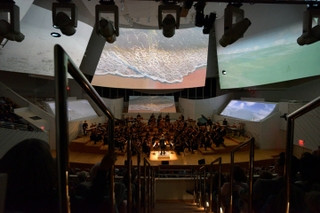|
Back
Mammoth Music-Making on Miami Beach Miami
New World Symphony Performing Center, 500 17th Street, Miami Beach, & New World Symphony Soundscape Park
01/30/2015 - & January 31, 2015
“New Work”:
Ted Hearne: Dispatches (World Premiere of NWS co-commission)
Bruce Hornsby: Shit’s Crazy Out Here: Three Songs: “Neighborhood Watch”, “Life in the Psychotropics”, “Where no One’s Mad” (World Premiere of Orchestration by Bruce Coughlin
Michael Gordon and Bill Morrison: El Sol Caliente (World Premiere of NWS)
Bruce Hornsby (Pianist/Vocalist), Sonny Emory (Drummer), Chris Croce (Bassist)
New World Symphony, Christian Reif (Conductor), Michael Tilson Thomas (Interlocutor/Musical Director/Interlocutor)

NWS Performance Hall (© New World Symphony–)
From the first pounding crashing chords of the whole New World Symphony, and the seven huge screens pulsing with pictures waves on the beach in Miami, Hector Berlioz would have been jealously watching from his heavenly aerie, thinking, “Now why the hell couldn’t I have thought of that?”
He died too soon. The New World Symphony, founded by Michael Tilson Thomas 26 years ago, does have the unique facilities and even more unique conception to make this kind of phenomenal music come to life. Last weekend was the fourth anniversary of an event called (with no imagination whatsoever) “New Work.” And for this reviewer, experiencing both the indoor performances and the following concert in the adjacent part on the 7,000-square foot screen, the event was a singular one.
The New World Symphony (NWS) itself will be explained in a later essay. But the 87-person ensemble, made up of professionally trained musicians who are on the way to join professional orchestras, have the benefit of this Frank Gehry-designed building in the middle of Miami Beach. And that is worth (and will have) another story by itself.
The building itself is in a soaring 80-foot-high curtain wall, giving full to the public of the space inside. But for this first concert the performance hall not only has the most stunning acoustics (amongst their permanent advisors are audio futurists from MIT), but those huge screens at the front and side of the stage.
For the inside performance that first night, they were used extensively for El Sol Caliente, a piece to celebrate the centenary of “independence” of Miami Beach from Miami. This was a collaboration between Miami–born composer Michael Gordon and filmmaker Bill Morrison. And whatever the merit of the work, the original impact was–to say the least–visually spectacular.
The music, alas, was (perhaps an accidental) clone of John Luther Adams’ Pulitzer Prize-winning Become Ocean. Both works presented a seemingly unending tapestry of music orchestral sound from beginning to end. The interchangeable works changed ever so slightly, were almost invariably played as loudly as possible and–in homage to the sea–was a series of waves rather than particles.
Mr. Adams had the benefit of no visual complements. Mr. Gordon was overshadowed by Mr. Morrison’s pictures, either simultaneously projected or with various scenes on the screen. The first third was of the waves on the shore, but the second third–gathered in Miami Beach archives–was a hodgepodge of mainly black-and-white archives. I supposed the choice was limited, but the choices were questionable. A flood, some bathing beauties, visiting celebs (Durante, Hope, Benny, the Beatles), Art Deco stuff and some reluctant bathing beauties. The original effect, with an ending of waves, was interesting enough. But the second hearing showed just what a specious choice this was.
Preceding this was the celebrity of the evening, the great Bruce Hornsby–who, with Tom Petty, must be the coolest most sophisticated singer on earth. He is also an amazing pianist, and his interests in Schoenberg. Ligeti and Webern was crystalized in an orchestral/vocal section of his SCKBSTDk
Musically, this was joyfully original. The first piece, sung by the gravel-voiced Mr. Hornsby, opened up a Ligeti-styled Atmosphéres in the strings. The following was inspired by the Prelude from Schoenberg’s Piano Suite, first played by Mr. Hornsby than transformed into a rhythmic motive adding to the song. The last two works had a similar opportunity to turn the vocal music into an intricate orchestral setting, highlighting not only the composer but solo drummer Sonny Emory and bassist Chris Croce.
The founder and musical director of New World Symphony, gave an introduction before giving the podium to the young NWS conductor, Christian Reif. Unfortunately, the opening work, Ted Hearne’s Dispatches with the most intricate program notes, and intricate orchestration (amplified guitars, wine corks into cello strings) and most fractionally intricate scoring had no effect whatsoever.

NWS Soundscape WallCast (© New World Symphony
The following night was even more interesting, since it was held in the adjacent public grounds (donated by the city), where a 2.5 acre public space contained a few hundred blankets, chairs and merry-makers enjoying the same concert on the SoundScape screen.
More on this screen will be written later. This, though, was a different audience. Younger, opening their wine-bottles and sandwiches and–thankfully–paying little attention to music, like Dispatches–which was hardly worthy of attention. The Bruce Hornsby piece, unfortunately, didn’t have the same effect (bad miking for the composer’s introductions), but the closeups of players was more intriguing.
As for the final El Sol Caliente, we caught only one of the seven screens (alas), though the dimensions were far greater (terrific), and while it still looked like a careless series of artificially structured historical shots, the effect at night under the full Miami moon was more than striking.
Harry Rolnick
|